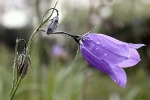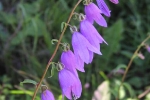These beautiful herbaceous plants are cultivated for ornamental purposes in gardens, on terraces and balconies but also in pots. Sometimes these deliberately plants have a role to cover unsightly walls in some nice way.

Most commonly plants which refer to Campanulas actually belong to the botanical genus of the same name, which lists about three hundred species of annual and perennial plants.
They are originated either from the Mediterranean Sea or from Asia or North America.
These indoor plants are parts of a very broad genre, from Gargani Campanula or small Carpathian, to the highest (50-60 cm) ones, such as Campanula persicifolia and more.
All campanulas produce similar flowers, mostly of them having a blue-violet color, and white or purple.
The campanules are widespread in gardens when they reach maturity. Among the easiest to grow are:
• Carpathian Campanula and colcearifolia brief: it may be seen in certain areas of the garden, covering walls. They are perennial flowers that bloom through spring;
• Campanula portenschlagiana: It is a perennial flower formed of low and thick bushes that cover in the spring the walls with small and tenderness bells;
• Campanula spicata: This plant produces flowers in clusters;
• Capmanula glomerata: These flowers blossom in a form of umbrella.
Campanula leaves are colored in green or green-blue, having a rounded shape. Strains have different lengths, according to varieties: from a few inches, dwarf plant specific, up to 60 cm. Some varieties have thin, flexible and hanging shoots; others are designed to cover certain areas of the garden or to hang over tapestry walls.
What make the distinction between species are the shaped flowers, those small and graceful bells downward sharp. The flowering lasts from May to August and at some varieties lasts until September-October.
The Campanulas love the half shadowed places, but away from drafts, developing well at moderate temperatures.
Ground must be moist and well drained, plus twice a month, around summer with small amounts of soluble fertilizer for flowering plants.
Watering is done regularly, without excesses, being abundant only in the vegetation period. In the winter period they rest, when the plant is kept in a lightly cool room (7-8 ° C); the earth is kept almost dry.
The Campanulas are a sort of resistant plants, being often attacked by aphids. In hot periods they form small red spider, inconspicuous to the naked eye but capable of permanently damages to the plant due to loss of leaves.
Campanulas Pictures Gallery



